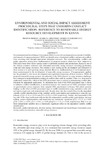Environmental And Social Impact Assessment Procedural Steps That Underpin Conflict Identification: Reference To Renewable Energy Resource Development In Kenya

View/
Date
2020-06-30Author
Omenge, Philip M
Obwoyere, Gilbert O
Eshiamwata, George W
Makindi, Stanley M
Nathwani, Jatin
Metadata
Show full item recordAbstract
Environmental and Social Impact Assessment (ESIA) is a tool for an integrated assessment of multifaceted impacts of a proposed project. ESIA can identify areas of potential conflicts and prevent conflicts
from occurring early through appropriate mitigation measures. This notwithstanding, conflicts and
public opposition arising from implementation of proposed projects which have been subjected to
ESIA have been observed in various sectors in different countries and jurisdictions. Kenya is one of
the African countries endowed with substantial renewable energy resources including geothermal,
wind and solar energy resources. The country is now scaling up the development and utilization of
these resources to meet growing energy demand. However, implementation of environmental procedures mainstreamed in the development of renewable energy resources, if inappropriately applied,
has the potential to slow down development and exploitation trajectory of these resources. While all
proposed renewable energy projects are subjected to the ESIA process, in some instances challenges
have emerged at implementation resulting in conflicts that could be avoided. There is a clear need to
understand, empirically, which of the ESIA procedural steps is critical in underpinning conflict identification for appropriate application. To determine how each of the ESIA procedural steps is likely
to influence conflict identification, a statistical analysis was carried out for ESIA procedures based
on questionnaire survey responses from sampled ESIA practitioners in Kenya. This article presents
findings on the effect of ESIA procedural steps in conflict identification using cumulative odds ordinal logistic regression with proportional odds. Results show that the overall effect (on the dependent
variable conflict identification) of the variables, public participation and monitoring is statically significant, χ2(2) = 9.12, p = 0.01 and χ2(2) = 6.29, p = 0.04, respectively. Further, the exponential of the
log odds of the slope coefficients indicate that the independent variables public participation, decision
making, project implementation and monitoring are statistically significant [χ2(1) = 9.12, p = 0.00;
χ2(1) = 4.04, p = 0.04; χ2(1) = 3.64, p = 0.05 and χ2(1) = 3.31, p = 0.00, respectively]. That is to say
these independent variables have a statistically significant effect on the dependent variable conflict
identification
